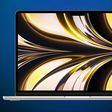The MacBook Air continues to be available in 13- and 15-inch sizes after Apple's latest refresh that added the M3 chip. The 15-inch MacBook Air offers almost all of the same hardware with a significantly larger display, yet there are still some key differences that are worth considering when purchasing one of the machines.

The 13- and 15-inch MacBook Air models are almost exactly the same in terms of feature set and design, both sporting high-resolution Liquid Retina displays, Touch ID, two Thunderbolt ports, and much more. Both machines can be configured with the exact same amounts of memory and storage, and they are both available in the same color options. This simplifies purchasing decisions to just a few important aspects.
Key Differences
| 13-inch MacBook Air | 15-inch MacBook Air |
|---|---|
| 13.6-inch Liquid Retina display | 15.3-inch Liquid Retina display |
| M2 or M3 chip | M3 chip |
| Starts with 8-Core GPU | 10-Core GPU |
| Four-speaker sound system | Six-speaker sound system with force-cancelling woofers |
| Integrated 52.6-watt-hour lithium-polymer battery | Integrated 66.5-watt-hour lithium-polymer battery |
| 30W USB-C Power Adapter (with 8-core GPU chip) or 35W Dual Port Compact Power Adapter | 35W Dual Port Compact Power Adapter |
| Starts at $999 | Starts at $1,299 |
It is important to note that while the 15-inch MacBook Air has a battery that is 13.9-watt-hours larger than the 13-inch model, both machines have the same 18-hour battery life. This is likely due to the increased power consumption of the larger display.
If you plan to heavily use your laptop's built-in speakers, the 15-inch model offers a worthwhile reason to get the larger model, offering two extra speakers inside the larger chassis. The smaller MacBook Air also misses out on the force-canceling woofers that are present in the 15-inch model, meaning that its audio isn't quite as good.
Since size is the main difference between the two MacBook Air models, prospective customers may wish to drill into the specific dimensions and weight of the machines. The 15-inch model adds 0.6 pounds (0.27 kg) and may be more difficult to get into a bag or backpack due to its larger footprint.
Dimensions
| 13-inch MacBook Air | 15-inch MacBook Air | |
|---|---|---|
| Height | 0.44 inch (1.13 cm) | 0.45 inch (1.15 cm) |
| Width | 11.97 inches (30.41 cm) | 13.40 inches (34.04 cm) |
| Depth | 8.46 inches (21.5 cm) | 9.35 inches (23.76 cm) |
| Weight | 2.7 pounds (1.24 kg) | 3.3 pounds (1.51 kg) |
While the 13-inch MacBook Air with the M3 chip starts at $1,099, making it $200 cheaper than the 15-inch model, if you choose the 13-inch MacBook Air with a 10-core GPU, this price difference shrinks to $100. If you add the 35W Dual Port Compact Power Adapter, the difference shrinks to just $80. With this in mind, most users considering an M3 model should opt for the 15-inch model since it provides much more screen real-estate and better speakers.
You should only buy the M3 13-inch MacBook Air if you specifically want a lighter, more portable device and are concerned about having to carry a device as large as the 15-inch model around. Likewise, the 13-inch MacBook Air is a better buy if you are price-conscious and don't need anything more than an 8-core GPU and the 30W USB-C Power Adapter. The $1,099 13-inch model is still quite a bit more affordable than the 15-inch MacBook Air, with virtually no compromises in terms of features.
The 13-inch MacBook Air is also available with the M2 chip for $999. This is the MacBook Air Apple introduced in mid-2022 and it now represents an entry-level model. If affordability is your main concern, this 13-inch model is the best choice, coming in at $300 less than the 15-inch M3 model.


















